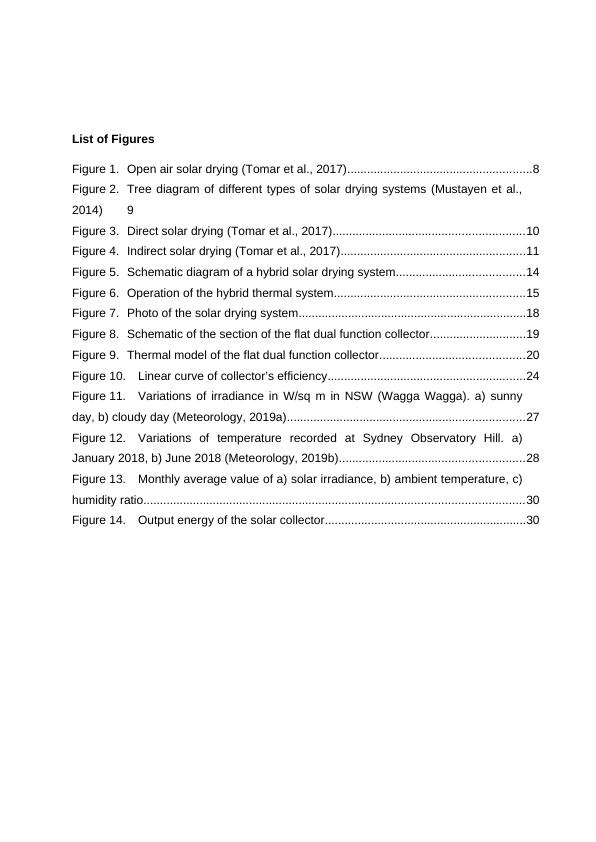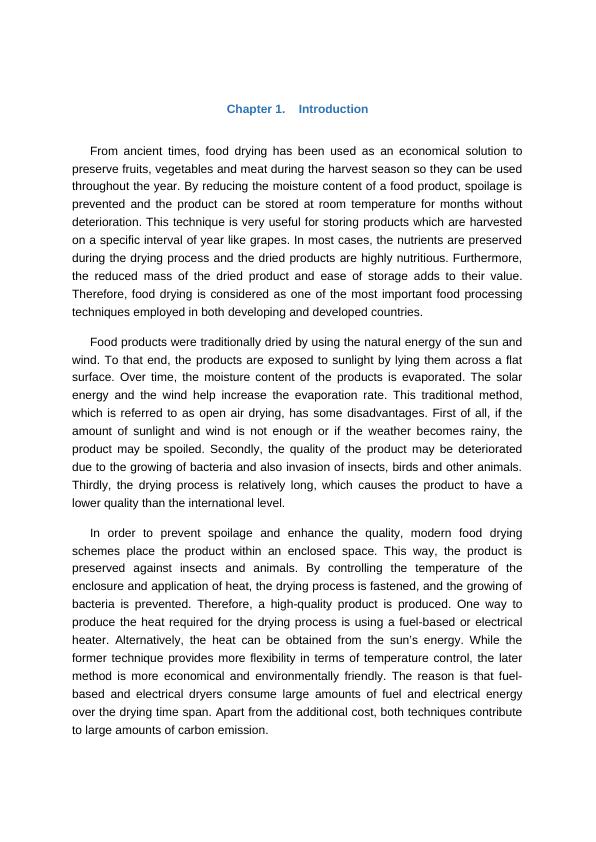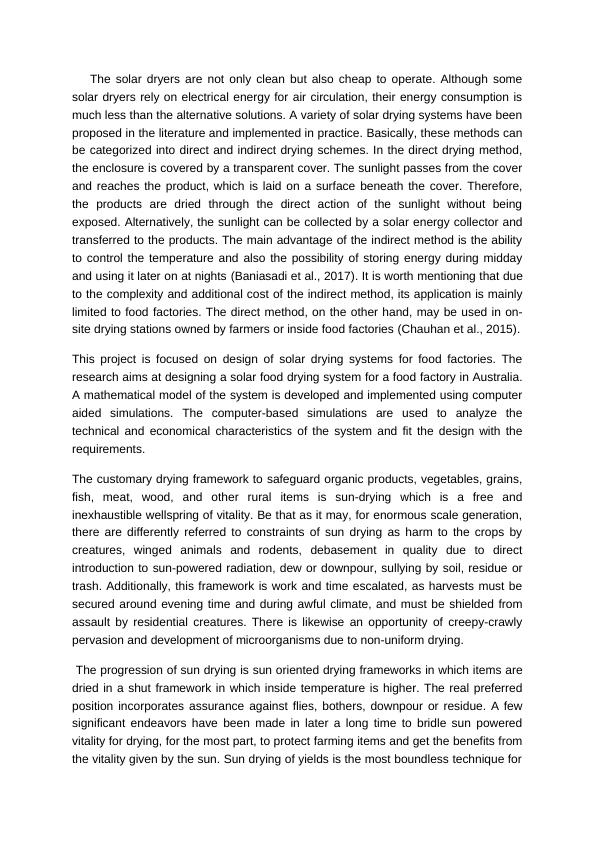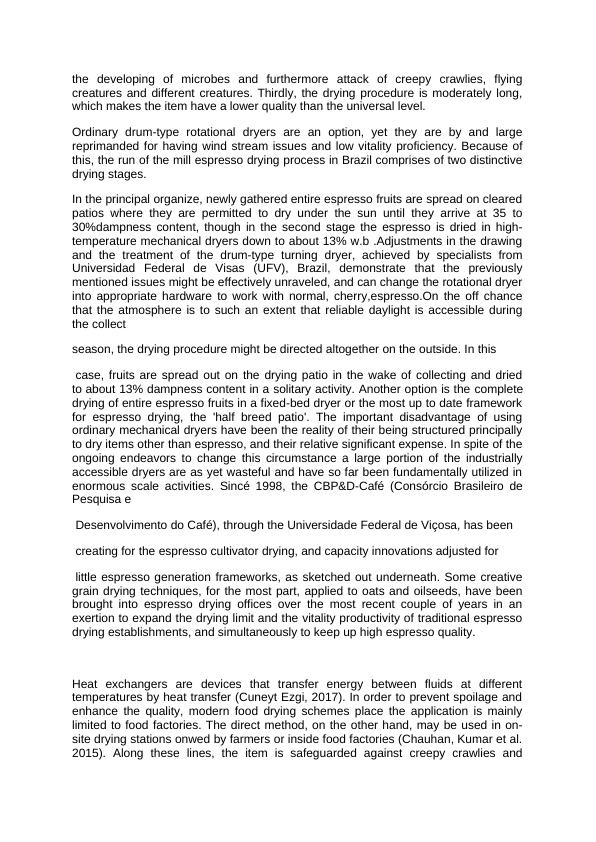Food Drying Solution 2022
Designing a solar drying system with a heat exchanger for a food factory in Australia, considering environmental conditions and the preservation of vitamins and color in dried food products.
56 Pages14996 Words17 Views
Added on 2022-10-03
Food Drying Solution 2022
Designing a solar drying system with a heat exchanger for a food factory in Australia, considering environmental conditions and the preservation of vitamins and color in dried food products.
Added on 2022-10-03
ShareRelated Documents

Abstract
Food drying is an economical solution to preserve crops, fruits and meat products
without refrigeration. Dried food products can be easily stored at room temperature
over a prolonged duration of time. Also, dried foods are highly marketable because
the ease of transporting, storing and distributing. Food drying can be accomplished
by a number of different methods. The simplest and oldest method is open-sun
drying, where the products are exposed to the sunlight by spreading them over a
surface. To enhance the quality and prevent spoilage, modern solar drying systems
are used. A solar drying system keeps the crops inside a drying chamber. The
required heat may be provided by direct application of the sunlight or by means of an
indirect drying system, where heat is collected by an absorber and then transferred
to the drying chamber. The advantage of indirect drying is the preservation of
vitamins and color. The choice of the type, size and mechanism of a solar drying
system is a challenging design task. In this project, a solar drying system with heat
exchanger is designed for a food factory in Australia. The design scheme takes into
account the environmental conditions (temperature, solar irradiation, etc.) at the
location of interest. Furthermore, the cost of the system is considered as a key
parameter in the design process. This way, a comprehensive design scheme will be
developed, which considers both physical and financial constraints.) Also, at the
location of interest. A result That find by using a heat exchanger is a highest and
lowest temperature out. Also Find an area of heat exchanger by measure a
temperature out.
Food drying is an economical solution to preserve crops, fruits and meat products
without refrigeration. Dried food products can be easily stored at room temperature
over a prolonged duration of time. Also, dried foods are highly marketable because
the ease of transporting, storing and distributing. Food drying can be accomplished
by a number of different methods. The simplest and oldest method is open-sun
drying, where the products are exposed to the sunlight by spreading them over a
surface. To enhance the quality and prevent spoilage, modern solar drying systems
are used. A solar drying system keeps the crops inside a drying chamber. The
required heat may be provided by direct application of the sunlight or by means of an
indirect drying system, where heat is collected by an absorber and then transferred
to the drying chamber. The advantage of indirect drying is the preservation of
vitamins and color. The choice of the type, size and mechanism of a solar drying
system is a challenging design task. In this project, a solar drying system with heat
exchanger is designed for a food factory in Australia. The design scheme takes into
account the environmental conditions (temperature, solar irradiation, etc.) at the
location of interest. Furthermore, the cost of the system is considered as a key
parameter in the design process. This way, a comprehensive design scheme will be
developed, which considers both physical and financial constraints.) Also, at the
location of interest. A result That find by using a heat exchanger is a highest and
lowest temperature out. Also Find an area of heat exchanger by measure a
temperature out.

Contents
Abstract..............................................................................................................................2
Chapter 1. Introduction....................................................................................................5
Chapter 2. Literature review............................................................................................7
2.1 Introduction...........................................................................................................7
2.2 Open air drying.....................................................................................................8
2.3 Solar drying systems............................................................................................9
2.3.1 Direct solar drying........................................................................................10
2.3.2 Indirect solar drying.....................................................................................11
2.4 Crop drying model..............................................................................................12
2.4.1 Concept of moisture content........................................................................12
2.4.2 Heat transfer model.....................................................................................13
2.4.3 Mass transfer model....................................................................................13
2.5 Hybrid solar drying system.................................................................................14
Chapter 3. Research questions.....................................................................................17
Chapter 4. Research Methodology................................................................................18
4.1.1 Mathematical modeling................................................................................18
4.1.2 System specifications..................................................................................21
4.2 Efficiency of flat plate solar collector..................................................................22
4.2.1 Mathematical analysis.................................................................................22
4.2.2 Evaluation of the efficiency curve for the selected collector........................24
Chapter 5. Data Collection............................................................................................26
Chapter 6. Preliminary Simulation results.....................................................................29
Chapter 7. Conclusions and future work.......................................................................31
Chapter 8. Timeline/ Project Management....................................................................33
References.......................................................................................................................34
Abstract..............................................................................................................................2
Chapter 1. Introduction....................................................................................................5
Chapter 2. Literature review............................................................................................7
2.1 Introduction...........................................................................................................7
2.2 Open air drying.....................................................................................................8
2.3 Solar drying systems............................................................................................9
2.3.1 Direct solar drying........................................................................................10
2.3.2 Indirect solar drying.....................................................................................11
2.4 Crop drying model..............................................................................................12
2.4.1 Concept of moisture content........................................................................12
2.4.2 Heat transfer model.....................................................................................13
2.4.3 Mass transfer model....................................................................................13
2.5 Hybrid solar drying system.................................................................................14
Chapter 3. Research questions.....................................................................................17
Chapter 4. Research Methodology................................................................................18
4.1.1 Mathematical modeling................................................................................18
4.1.2 System specifications..................................................................................21
4.2 Efficiency of flat plate solar collector..................................................................22
4.2.1 Mathematical analysis.................................................................................22
4.2.2 Evaluation of the efficiency curve for the selected collector........................24
Chapter 5. Data Collection............................................................................................26
Chapter 6. Preliminary Simulation results.....................................................................29
Chapter 7. Conclusions and future work.......................................................................31
Chapter 8. Timeline/ Project Management....................................................................33
References.......................................................................................................................34

List of Figures
Figure 1. Open air solar drying (Tomar et al., 2017)........................................................8
Figure 2. Tree diagram of different types of solar drying systems (Mustayen et al.,
2014) 9
Figure 3. Direct solar drying (Tomar et al., 2017)..........................................................10
Figure 4. Indirect solar drying (Tomar et al., 2017)........................................................11
Figure 5. Schematic diagram of a hybrid solar drying system.......................................14
Figure 6. Operation of the hybrid thermal system..........................................................15
Figure 7. Photo of the solar drying system.....................................................................18
Figure 8. Schematic of the section of the flat dual function collector.............................19
Figure 9. Thermal model of the flat dual function collector............................................20
Figure 10. Linear curve of collector’s efficiency............................................................24
Figure 11. Variations of irradiance in W/sq m in NSW (Wagga Wagga). a) sunny
day, b) cloudy day (Meteorology, 2019a)........................................................................27
Figure 12. Variations of temperature recorded at Sydney Observatory Hill. a)
January 2018, b) June 2018 (Meteorology, 2019b)........................................................28
Figure 13. Monthly average value of a) solar irradiance, b) ambient temperature, c)
humidity ratio...................................................................................................................30
Figure 14. Output energy of the solar collector.............................................................30
Figure 1. Open air solar drying (Tomar et al., 2017)........................................................8
Figure 2. Tree diagram of different types of solar drying systems (Mustayen et al.,
2014) 9
Figure 3. Direct solar drying (Tomar et al., 2017)..........................................................10
Figure 4. Indirect solar drying (Tomar et al., 2017)........................................................11
Figure 5. Schematic diagram of a hybrid solar drying system.......................................14
Figure 6. Operation of the hybrid thermal system..........................................................15
Figure 7. Photo of the solar drying system.....................................................................18
Figure 8. Schematic of the section of the flat dual function collector.............................19
Figure 9. Thermal model of the flat dual function collector............................................20
Figure 10. Linear curve of collector’s efficiency............................................................24
Figure 11. Variations of irradiance in W/sq m in NSW (Wagga Wagga). a) sunny
day, b) cloudy day (Meteorology, 2019a)........................................................................27
Figure 12. Variations of temperature recorded at Sydney Observatory Hill. a)
January 2018, b) June 2018 (Meteorology, 2019b)........................................................28
Figure 13. Monthly average value of a) solar irradiance, b) ambient temperature, c)
humidity ratio...................................................................................................................30
Figure 14. Output energy of the solar collector.............................................................30

Chapter 1. Introduction
From ancient times, food drying has been used as an economical solution to
preserve fruits, vegetables and meat during the harvest season so they can be used
throughout the year. By reducing the moisture content of a food product, spoilage is
prevented and the product can be stored at room temperature for months without
deterioration. This technique is very useful for storing products which are harvested
on a specific interval of year like grapes. In most cases, the nutrients are preserved
during the drying process and the dried products are highly nutritious. Furthermore,
the reduced mass of the dried product and ease of storage adds to their value.
Therefore, food drying is considered as one of the most important food processing
techniques employed in both developing and developed countries.
Food products were traditionally dried by using the natural energy of the sun and
wind. To that end, the products are exposed to sunlight by lying them across a flat
surface. Over time, the moisture content of the products is evaporated. The solar
energy and the wind help increase the evaporation rate. This traditional method,
which is referred to as open air drying, has some disadvantages. First of all, if the
amount of sunlight and wind is not enough or if the weather becomes rainy, the
product may be spoiled. Secondly, the quality of the product may be deteriorated
due to the growing of bacteria and also invasion of insects, birds and other animals.
Thirdly, the drying process is relatively long, which causes the product to have a
lower quality than the international level.
In order to prevent spoilage and enhance the quality, modern food drying
schemes place the product within an enclosed space. This way, the product is
preserved against insects and animals. By controlling the temperature of the
enclosure and application of heat, the drying process is fastened, and the growing of
bacteria is prevented. Therefore, a high-quality product is produced. One way to
produce the heat required for the drying process is using a fuel-based or electrical
heater. Alternatively, the heat can be obtained from the sun’s energy. While the
former technique provides more flexibility in terms of temperature control, the later
method is more economical and environmentally friendly. The reason is that fuel-
based and electrical dryers consume large amounts of fuel and electrical energy
over the drying time span. Apart from the additional cost, both techniques contribute
to large amounts of carbon emission.
From ancient times, food drying has been used as an economical solution to
preserve fruits, vegetables and meat during the harvest season so they can be used
throughout the year. By reducing the moisture content of a food product, spoilage is
prevented and the product can be stored at room temperature for months without
deterioration. This technique is very useful for storing products which are harvested
on a specific interval of year like grapes. In most cases, the nutrients are preserved
during the drying process and the dried products are highly nutritious. Furthermore,
the reduced mass of the dried product and ease of storage adds to their value.
Therefore, food drying is considered as one of the most important food processing
techniques employed in both developing and developed countries.
Food products were traditionally dried by using the natural energy of the sun and
wind. To that end, the products are exposed to sunlight by lying them across a flat
surface. Over time, the moisture content of the products is evaporated. The solar
energy and the wind help increase the evaporation rate. This traditional method,
which is referred to as open air drying, has some disadvantages. First of all, if the
amount of sunlight and wind is not enough or if the weather becomes rainy, the
product may be spoiled. Secondly, the quality of the product may be deteriorated
due to the growing of bacteria and also invasion of insects, birds and other animals.
Thirdly, the drying process is relatively long, which causes the product to have a
lower quality than the international level.
In order to prevent spoilage and enhance the quality, modern food drying
schemes place the product within an enclosed space. This way, the product is
preserved against insects and animals. By controlling the temperature of the
enclosure and application of heat, the drying process is fastened, and the growing of
bacteria is prevented. Therefore, a high-quality product is produced. One way to
produce the heat required for the drying process is using a fuel-based or electrical
heater. Alternatively, the heat can be obtained from the sun’s energy. While the
former technique provides more flexibility in terms of temperature control, the later
method is more economical and environmentally friendly. The reason is that fuel-
based and electrical dryers consume large amounts of fuel and electrical energy
over the drying time span. Apart from the additional cost, both techniques contribute
to large amounts of carbon emission.

The solar dryers are not only clean but also cheap to operate. Although some
solar dryers rely on electrical energy for air circulation, their energy consumption is
much less than the alternative solutions. A variety of solar drying systems have been
proposed in the literature and implemented in practice. Basically, these methods can
be categorized into direct and indirect drying schemes. In the direct drying method,
the enclosure is covered by a transparent cover. The sunlight passes from the cover
and reaches the product, which is laid on a surface beneath the cover. Therefore,
the products are dried through the direct action of the sunlight without being
exposed. Alternatively, the sunlight can be collected by a solar energy collector and
transferred to the products. The main advantage of the indirect method is the ability
to control the temperature and also the possibility of storing energy during midday
and using it later on at nights (Baniasadi et al., 2017). It is worth mentioning that due
to the complexity and additional cost of the indirect method, its application is mainly
limited to food factories. The direct method, on the other hand, may be used in on-
site drying stations owned by farmers or inside food factories (Chauhan et al., 2015).
This project is focused on design of solar drying systems for food factories. The
research aims at designing a solar food drying system for a food factory in Australia.
A mathematical model of the system is developed and implemented using computer
aided simulations. The computer-based simulations are used to analyze the
technical and economical characteristics of the system and fit the design with the
requirements.
The customary drying framework to safeguard organic products, vegetables, grains,
fish, meat, wood, and other rural items is sun-drying which is a free and
inexhaustible wellspring of vitality. Be that as it may, for enormous scale generation,
there are differently referred to constraints of sun drying as harm to the crops by
creatures, winged animals and rodents, debasement in quality due to direct
introduction to sun-powered radiation, dew or downpour, sullying by soil, residue or
trash. Additionally, this framework is work and time escalated, as harvests must be
secured around evening time and during awful climate, and must be shielded from
assault by residential creatures. There is likewise an opportunity of creepy-crawly
pervasion and development of microorganisms due to non-uniform drying.
The progression of sun drying is sun oriented drying frameworks in which items are
dried in a shut framework in which inside temperature is higher. The real preferred
position incorporates assurance against flies, bothers, downpour or residue. A few
significant endeavors have been made in later a long time to bridle sun powered
vitality for drying, for the most part, to protect farming items and get the benefits from
the vitality given by the sun. Sun drying of yields is the most boundless technique for
solar dryers rely on electrical energy for air circulation, their energy consumption is
much less than the alternative solutions. A variety of solar drying systems have been
proposed in the literature and implemented in practice. Basically, these methods can
be categorized into direct and indirect drying schemes. In the direct drying method,
the enclosure is covered by a transparent cover. The sunlight passes from the cover
and reaches the product, which is laid on a surface beneath the cover. Therefore,
the products are dried through the direct action of the sunlight without being
exposed. Alternatively, the sunlight can be collected by a solar energy collector and
transferred to the products. The main advantage of the indirect method is the ability
to control the temperature and also the possibility of storing energy during midday
and using it later on at nights (Baniasadi et al., 2017). It is worth mentioning that due
to the complexity and additional cost of the indirect method, its application is mainly
limited to food factories. The direct method, on the other hand, may be used in on-
site drying stations owned by farmers or inside food factories (Chauhan et al., 2015).
This project is focused on design of solar drying systems for food factories. The
research aims at designing a solar food drying system for a food factory in Australia.
A mathematical model of the system is developed and implemented using computer
aided simulations. The computer-based simulations are used to analyze the
technical and economical characteristics of the system and fit the design with the
requirements.
The customary drying framework to safeguard organic products, vegetables, grains,
fish, meat, wood, and other rural items is sun-drying which is a free and
inexhaustible wellspring of vitality. Be that as it may, for enormous scale generation,
there are differently referred to constraints of sun drying as harm to the crops by
creatures, winged animals and rodents, debasement in quality due to direct
introduction to sun-powered radiation, dew or downpour, sullying by soil, residue or
trash. Additionally, this framework is work and time escalated, as harvests must be
secured around evening time and during awful climate, and must be shielded from
assault by residential creatures. There is likewise an opportunity of creepy-crawly
pervasion and development of microorganisms due to non-uniform drying.
The progression of sun drying is sun oriented drying frameworks in which items are
dried in a shut framework in which inside temperature is higher. The real preferred
position incorporates assurance against flies, bothers, downpour or residue. A few
significant endeavors have been made in later a long time to bridle sun powered
vitality for drying, for the most part, to protect farming items and get the benefits from
the vitality given by the sun. Sun drying of yields is the most boundless technique for

nourishment conservation in most pieces of India and the world in light of sun-based
irradiance being very high for the greater part of the year. As this strategy needs no
vitality during day time, it is more beneficial to the little scale ranchers who can't
a ord the power or other fuel for drying. On the off chance that it is important to dryff
items in the night or awful climate, an extra bio-fueled radiator can be utilized for
warmth supply. Because of their high dampness content at gather, 60 to 70% web,
common ready espresso fruits don't stream effectively in taking care of gear (for
example gravity gushes, containers, can lifts, wood screws) and traditional
mechanical dryers.
The rest of the report is organized as follows. To gain an in depth understanding of
the research field, the structure and mathematical model of food drying systems are
reviewed in Chapter 2. Then, the specific research objectives are indicated in
Chapter 3 in the form of a list of questions. Next, the research methodology including
mathematical model of the proposed solar drying system is detailed in Chapter 4.
The data collection including assessment of weather conditions is addressed in
Chapter 5. Chapter 6 presents some preliminary simulation results obtained from F-
charts program. Conclusion and project management are then presented in
Chapters 7 and 8.
Once of the major objectives to have a temperature for a given amount of heat
transferred by design of heat exchanger. A heat exchanger have a crossflow tubular
have been studied by many investigators, with most of the experiments performed
on exchangers (E.K. Ruth 1983). From old occasions, sustenance drying has been
utilized as a practical answer for protect natural products, vegetables and meat
during the reap season so they can be utilized consistently. By lessening the
dampness substance of a sustenance item, decay is counteracted, and the item can
be put away at room temperature for quite a long time without weakening. This
procedure is exceptionally helpful for putting away items which are gathered on a
particular interim of year like grapes. Much of the time, the supplements are
protected during the drying procedure and the dried items are exceptionally
nutritious. Besides, the decreased mass of the dried item and simplicity of capacity
adds to their worth. Accordingly, sustenance drying is considered as one of the most
significant nourishment handling methods utilized in both creating and created
nations. growing of bacteria and also invasion of Nourishment items were
customarily dried by utilizing the regular vitality of the sun and wind. With that in
mind, the items are presented to daylight by lying them over a level surface. After
some time, the dampness substance of the items is dissipated. The sun based
vitality and the breeze help increment the dissipation rate. Additionally, with utilizing
heat exchanger there will be more item and best quality. This customary strategy,
which is alluded to as outdoors drying, has a few detriments. Above all else, if the
measure of daylight and wind isn't sufficient or if the climate ends up blustery, the
item might be ruined. Besides, the nature of the item might be crumbled because of
irradiance being very high for the greater part of the year. As this strategy needs no
vitality during day time, it is more beneficial to the little scale ranchers who can't
a ord the power or other fuel for drying. On the off chance that it is important to dryff
items in the night or awful climate, an extra bio-fueled radiator can be utilized for
warmth supply. Because of their high dampness content at gather, 60 to 70% web,
common ready espresso fruits don't stream effectively in taking care of gear (for
example gravity gushes, containers, can lifts, wood screws) and traditional
mechanical dryers.
The rest of the report is organized as follows. To gain an in depth understanding of
the research field, the structure and mathematical model of food drying systems are
reviewed in Chapter 2. Then, the specific research objectives are indicated in
Chapter 3 in the form of a list of questions. Next, the research methodology including
mathematical model of the proposed solar drying system is detailed in Chapter 4.
The data collection including assessment of weather conditions is addressed in
Chapter 5. Chapter 6 presents some preliminary simulation results obtained from F-
charts program. Conclusion and project management are then presented in
Chapters 7 and 8.
Once of the major objectives to have a temperature for a given amount of heat
transferred by design of heat exchanger. A heat exchanger have a crossflow tubular
have been studied by many investigators, with most of the experiments performed
on exchangers (E.K. Ruth 1983). From old occasions, sustenance drying has been
utilized as a practical answer for protect natural products, vegetables and meat
during the reap season so they can be utilized consistently. By lessening the
dampness substance of a sustenance item, decay is counteracted, and the item can
be put away at room temperature for quite a long time without weakening. This
procedure is exceptionally helpful for putting away items which are gathered on a
particular interim of year like grapes. Much of the time, the supplements are
protected during the drying procedure and the dried items are exceptionally
nutritious. Besides, the decreased mass of the dried item and simplicity of capacity
adds to their worth. Accordingly, sustenance drying is considered as one of the most
significant nourishment handling methods utilized in both creating and created
nations. growing of bacteria and also invasion of Nourishment items were
customarily dried by utilizing the regular vitality of the sun and wind. With that in
mind, the items are presented to daylight by lying them over a level surface. After
some time, the dampness substance of the items is dissipated. The sun based
vitality and the breeze help increment the dissipation rate. Additionally, with utilizing
heat exchanger there will be more item and best quality. This customary strategy,
which is alluded to as outdoors drying, has a few detriments. Above all else, if the
measure of daylight and wind isn't sufficient or if the climate ends up blustery, the
item might be ruined. Besides, the nature of the item might be crumbled because of

the developing of microbes and furthermore attack of creepy crawlies, flying
creatures and different creatures. Thirdly, the drying procedure is moderately long,
which makes the item have a lower quality than the universal level.
Ordinary drum-type rotational dryers are an option, yet they are by and large
reprimanded for having wind stream issues and low vitality proficiency. Because of
this, the run of the mill espresso drying process in Brazil comprises of two distinctive
drying stages.
In the principal organize, newly gathered entire espresso fruits are spread on cleared
patios where they are permitted to dry under the sun until they arrive at 35 to
30%dampness content, though in the second stage the espresso is dried in high-
temperature mechanical dryers down to about 13% w.b .Adjustments in the drawing
and the treatment of the drum-type turning dryer, achieved by specialists from
Universidad Federal de Visas (UFV), Brazil, demonstrate that the previously
mentioned issues might be effectively unraveled, and can change the rotational dryer
into appropriate hardware to work with normal, cherry,espresso.On the off chance
that the atmosphere is to such an extent that reliable daylight is accessible during
the collect
season, the drying procedure might be directed altogether on the outside. In this
case, fruits are spread out on the drying patio in the wake of collecting and dried
to about 13% dampness content in a solitary activity. Another option is the complete
drying of entire espresso fruits in a fixed-bed dryer or the most up to date framework
for espresso drying, the 'half breed patio'. The important disadvantage of using
ordinary mechanical dryers have been the reality of their being structured principally
to dry items other than espresso, and their relative significant expense. In spite of the
ongoing endeavors to change this circumstance a large portion of the industrially
accessible dryers are as yet wasteful and have so far been fundamentally utilized in
enormous scale activities. Sincé 1998, the CBP&D-Café (Consórcio Brasileiro de
Pesquisa e
Desenvolvimento do Café), through the Universidade Federal de Viçosa, has been
creating for the espresso cultivator drying, and capacity innovations adjusted for
little espresso generation frameworks, as sketched out underneath. Some creative
grain drying techniques, for the most part, applied to oats and oilseeds, have been
brought into espresso drying offices over the most recent couple of years in an
exertion to expand the drying limit and the vitality productivity of traditional espresso
drying establishments, and simultaneously to keep up high espresso quality.
Heat exchangers are devices that transfer energy between fluids at different
temperatures by heat transfer (Cuneyt Ezgi, 2017). In order to prevent spoilage and
enhance the quality, modern food drying schemes place the application is mainly
limited to food factories. The direct method, on the other hand, may be used in on-
site drying stations onwed by farmers or inside food factories (Chauhan, Kumar et al.
2015). Along these lines, the item is safeguarded against creepy crawlies and
creatures and different creatures. Thirdly, the drying procedure is moderately long,
which makes the item have a lower quality than the universal level.
Ordinary drum-type rotational dryers are an option, yet they are by and large
reprimanded for having wind stream issues and low vitality proficiency. Because of
this, the run of the mill espresso drying process in Brazil comprises of two distinctive
drying stages.
In the principal organize, newly gathered entire espresso fruits are spread on cleared
patios where they are permitted to dry under the sun until they arrive at 35 to
30%dampness content, though in the second stage the espresso is dried in high-
temperature mechanical dryers down to about 13% w.b .Adjustments in the drawing
and the treatment of the drum-type turning dryer, achieved by specialists from
Universidad Federal de Visas (UFV), Brazil, demonstrate that the previously
mentioned issues might be effectively unraveled, and can change the rotational dryer
into appropriate hardware to work with normal, cherry,espresso.On the off chance
that the atmosphere is to such an extent that reliable daylight is accessible during
the collect
season, the drying procedure might be directed altogether on the outside. In this
case, fruits are spread out on the drying patio in the wake of collecting and dried
to about 13% dampness content in a solitary activity. Another option is the complete
drying of entire espresso fruits in a fixed-bed dryer or the most up to date framework
for espresso drying, the 'half breed patio'. The important disadvantage of using
ordinary mechanical dryers have been the reality of their being structured principally
to dry items other than espresso, and their relative significant expense. In spite of the
ongoing endeavors to change this circumstance a large portion of the industrially
accessible dryers are as yet wasteful and have so far been fundamentally utilized in
enormous scale activities. Sincé 1998, the CBP&D-Café (Consórcio Brasileiro de
Pesquisa e
Desenvolvimento do Café), through the Universidade Federal de Viçosa, has been
creating for the espresso cultivator drying, and capacity innovations adjusted for
little espresso generation frameworks, as sketched out underneath. Some creative
grain drying techniques, for the most part, applied to oats and oilseeds, have been
brought into espresso drying offices over the most recent couple of years in an
exertion to expand the drying limit and the vitality productivity of traditional espresso
drying establishments, and simultaneously to keep up high espresso quality.
Heat exchangers are devices that transfer energy between fluids at different
temperatures by heat transfer (Cuneyt Ezgi, 2017). In order to prevent spoilage and
enhance the quality, modern food drying schemes place the application is mainly
limited to food factories. The direct method, on the other hand, may be used in on-
site drying stations onwed by farmers or inside food factories (Chauhan, Kumar et al.
2015). Along these lines, the item is safeguarded against creepy crawlies and

End of preview
Want to access all the pages? Upload your documents or become a member.
